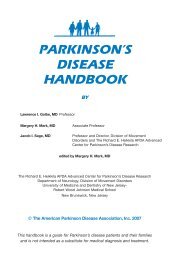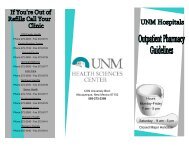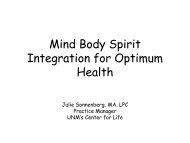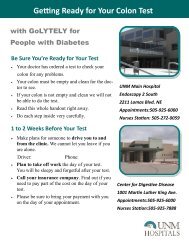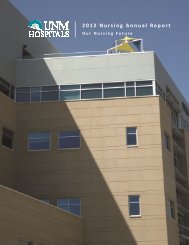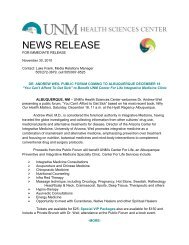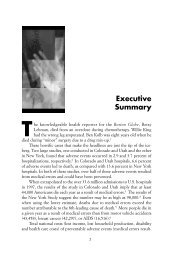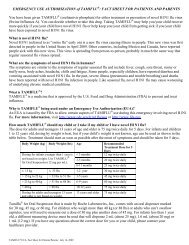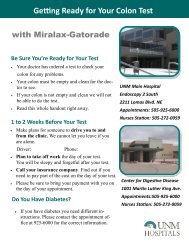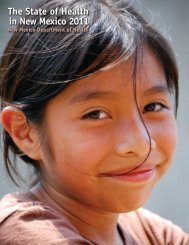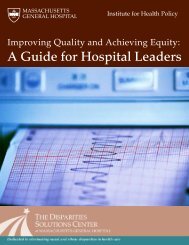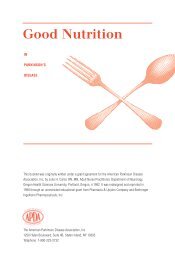Health Equity Quiz (pdf) - Unnatural Causes
Health Equity Quiz (pdf) - Unnatural Causes
Health Equity Quiz (pdf) - Unnatural Causes
Create successful ePaper yourself
Turn your PDF publications into a flip-book with our unique Google optimized e-Paper software.
ANSWER: E. 1.7 acres. That’s almost 19 times more green space in white neighborhoods than Blackand Latino neighborhoods! More parks means cleaner air, room to exercise and play, a place forcommunity members to gather, not to mention higher property values and increased desirability.Source: Pincetl, Stephanie et al. (March 2003). Toward a Sustainable Los Angeles: A ‘Nature’s Services’ Approach. Report fromthe University of Southern California Center for Sustainable Cities.(http://www.usc.edu/dept/geography/ESPE/documents/report_haynes.<strong>pdf</strong>)9. How much does chronic illness cost the U.S. each year in lost work productivity?A. $105 millionB. $601 millionC. $2.2 billionD. $153 billionE. $1.1 trillionANSWER: E. $1.1 trillion. According to a 2007 study by the Milken Institute, the financial burden ofchronic illnesses such as heart disease and diabetes goes far beyond actual medical expenses ($277billion in 2003). Our poor health takes a even greater toll on economic productivity in the form of extrasick days, reduced performance by ailing workers and other losses not directly related to medical care.Source: DeVol, Ross & Armen Bedroussian. (October 2007). Unhealthy America: The Economic Burden of Chronic Disease.Report from The Milken Institute. (http://www.chronicdiseaseimpact.com)10. African American men in Harlem have a shorter life expectancy from age five than which ofthe following groups?A. JapaneseB. BangladeshisC. CubansD. Algerians living in ParisE. All of the aboveANSWER: E. All of the above. Even males in Bangladesh, one of the poorest countries in the world,have a better chance of reaching age 65 than African American males in Harlem. The biggest killers inpoor African American communities are not drugs or bullets but chronic diseases like stroke, diabetesand heart disease. Former Surgeon General Dr. David Satcher and colleagues calculated that 83,000African American “excess” deaths could have been prevented in 2002 if Black-white differences inmortality were eliminated.Sources: (1) McCord C., & H.P. Freeman. (1990). “Excess Mortality in Harlem.” New England Journal of Medicine, 322(3), 173-177. (http://content.nejm.org/cgi/content/abstract/322/3/173)(2) Satcher, D. et al. (2005). “What If We Were Equal? A Comparison of the Black-White Mortality Gap in 1960 and 2000.” <strong>Health</strong>Affairs, 24(2), 459-464. (http://content.healthaffairs.org/cgi/content/abstract/24/2/459)11. On average, which of the following is the best predictor of one’s health?A. whether or not you smokeB. what you eatC. whether or not you are wealthyD. whether or not you have health insuranceE. how often you exerciseANSWER: C. Whether or not you are wealthy. The single strongest predictor of health is our position onthe class pyramid. Those at the top have the most power and resources, and on average live longerand healthier lives. Those on the bottom are exposed to many health threats over which they have littleor no control – insecure and low-paying jobs, mounting debt, poor child care, poor quality housing, lessaccess to healthy food, unreliable transportation, and noisy and violent living conditions – that increasetheir risk of chronic disease and early death. Even among smokers, poor smokers face a highermortality risk than rich smokers. Those of us in the middle are still worse off than those at the top.Source: Adler, N.E. et al. (2007). Reaching for a <strong>Health</strong>ier Life: Facts on Socioeconomic Status and <strong>Health</strong> in the U.S. Reportfrom the Macarthur Foundation Research Network on Socioeconomic Status and <strong>Health</strong>.(http://www.macses.ucsf.edu/News/Reaching%20for%20a%20<strong>Health</strong>ier%20Life.<strong>pdf</strong>)© California Newsreel www.unnaturalcauses.org Page 3



